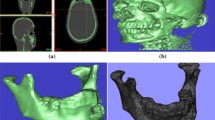Abstract
This paper investigates the errors generated during the fabrication stage for producing complex anatomical replicas derived from computed tomography coupled with the 3D additive manufacturing methods. Based on this research work, it is shown that patient-specific model based on computed tomography data can be converted into computer numerically controlled G-code. It is shown that 3D extrusion-based additive manufacturing technology is accurate to ±3 % equating to ±200 μm surface deviations due to plastic shrinkage and distortion formed during the process. Polylactic acid plastic extrusion through a 200-μm bore nozzle has resulted in a model being produced with an Ra roughness of 35.5 μm. An evaluation on the errors generated during the fabrication process has been used to accurately produce an adult female mandible. Internal nerve channels and complex external bone geometry has been produced within the model. It is shown that using this process results in bone complexity and accuracy required for producing low-cost surgical grades models which is in comparison with traditional selective laser sintering manufacturing techniques. The surface accuracies suggest that the reproduction of anatomically complex representative structures by 3D plastic extrusion additive manufacturing which can be used for pre-surgical planning.
Similar content being viewed by others
References
Bibb R (2006) Medical modelling: the application of advanced design and development techniques in medicine. University of Wales, UK
Jacobs P (1995) Stereolithography and other RP & M technologies from rapid prototyping to rapid tooling. ASME press
Barker TM, Earwalker WJ, Frost H, Wakeley G (1993) Integration of 3D medical imaging and rapid prototyping to create stereolithographic models. Aust Phys Eng Sci Med 16:79–85
Fan X, Zhou H, Lin M, Fu Y, Li J (2007) Late reconstruction of the complex orbital fractures with computer-aided design and computer-aided manufacturing technique. J Craniofacial Surg 18(3):665–673
Milovanovic J (2005) Possibilities of using selective laser melting for tire mould manufacturing, Proceedings. Second international Conference on Manufacturing Engineering Icmen, Kallithea of Chalkidiki, Greece 187-93
Tukuru N, Gowda S, Mansoor KP, Ahmed S, Badami S (2008) Rapid prototype technique in medical field research. J Pharm Tech 1(4):341–344
Udupa JK, Goncalves RJ (1996) Imaging transforms for volume visualisation, in computer integrated surgery. Comput Integr Surg: Technol Clin Appl 3:33–57
Swalens B, Kruth JP (1993) Medical application of rapid prototyping techniques. Fourth International conference on rapid prototyping 107-20
Gibson I, Cheung LK, Chow SP, Cheung WL, Beh SL, Savalani M, Lee SH (2006) The use of rapid prototyping to assist medical applications. Rapid Prototyp J 12:53–58
Robiony M, Salvo I, Costa F, Zerman N, Bazzocchi M, Toso F, Bandera C, Filippi S, Felice M, Politi M (2007) Virtual reality surgical planning for maxillofacial distraction osteogenesis: the role of reverse engineering rapid prototyping and cooperative work. J Oral Maxillofac Surg 65(6):1198–1208
Winder J, Bibb R (2005) Medical rapid prototyping technologies-state of the art and current limitations for application in oral and maxillofacial surgery. J Oral Maxillofac Surg 63(7):1006–1015
Gibson I (2006) Advanced manufacturing technology for medical applications- reverse engineering, software conversion and rapid prototyping. Wiley 254
Silva DN, Oliveira MG, Meurer E, Meurer MI, Lopes da Silva JV (2008) Dimensional error in selective laser sintering and 3D-printing of models for craniomaxillary anatomy reconstruction. J Cranio-Maxillofac Surg 36(8):443–449
Ngan E, Rebeyka I, Ross D, Hirji M, Wolfaardt J, Dent M, Seelaus R, Grosvenor A, Noga M (2006) The rapid prototyping of anatomic models in pulmonary atresia. J Thorac Cardiovasc Surg 132(2):264–269
Ma D, Lin F, Chua CK (2001) Rapid prototyping applications in medicine. Part 2: STL File. Generation and case studies. Int J Adv Manuf Technol 18:118–127
Kouhi E, Masood S, Morsi Y (2008) Design and fabrication of reconstructive mandibular models using fused deposition modelling. Rapid Prototyp J 28(3):246–254
Katatny IE, Masood SH, Morsi YS (2009) Evaluation and validation of the shape accuracy of FDM fabricated medical models. Adv Mater Res 275:83–86
Katatny IE, Masood SH, Morsi YS (2010) Error analysis of FDM fabricated medical replicas. Rapid Prototyp J 16:36–43
Author information
Authors and Affiliations
Corresponding author
Rights and permissions
About this article
Cite this article
Thomas, D.J., Azmi, M.A.B.M. & Tehrani, Z. 3D additive manufacture of oral and maxillofacial surgical models for preoperative planning. Int J Adv Manuf Technol 71, 1643–1651 (2014). https://doi.org/10.1007/s00170-013-5587-4
Received:
Accepted:
Published:
Issue Date:
DOI: https://doi.org/10.1007/s00170-013-5587-4




